How to Buy, Choose and Care for Pet Geckos
Geckos are perfect pets for the beginner or intermediate
herptologist. There are over 1000 types of these lizards, although only
8 types are widely sold in pet stores and make good pets. They are
recommended for children 10 and up with the
supervision of an adult. These lizards are unique based on the abilty
of most to use the toe pads to climb. Most lay eggs, but some give
birth to live babies. They are found in warm weather areas such as the
tropics and deserts. Younger lizards have stripes which then turn
to spots. Most make some type of noise (expect Leopard
Geckos). Adults shed 2 to 4 times per year while babies shed
every week or so. They grow to between 4" and 10" depending on
the type, and are perfect for anyone that live or only can spare a
small space.
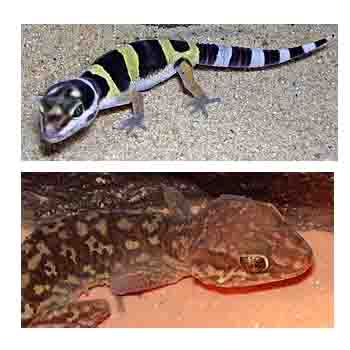
Popular Pet Lizards are the Leopard and Panther
- Recommended for Beginners
- Eyelash Crested
- Gargoyle
- Panther (also called Madagascar,
Ground, Ocelot, Pictus )
- Leopard Geckos
- Recommended for Intermediates
Capture Lizards in the Wild or Purchase from a Pet or Online Store?
Pet reptiles are either caught in the wild or purchased from a breeder. Both types are found in pet stores. We always recommend purchasing lizards that were bred in captivity. They have fewer lizard diseases, and are started on a proper diet. Lizards bred in captivity also have already adapted to this type of habitat.
Prior to purchasing your lizard, check the body condition for signs of poor health. This can be brought on by parasites or malnutrition. Signs of health problems include:- Skin injuries or trauma
- Skin swelling, or discolored skin
- Discharge fro nose or eyes
- Missing limbs
- Mites which cause head twitching against the side of the terrarium
- Red spots on the body indicate nutrition problems
- labored breathing
- lethargy (tired, slow behavior)
- Shedding problems
- weight loss
- no appetite
- diarrhea
- Bright, clear, clean eyes (no cloudy appearance)
- Normal gait (walks like you would expect)
- Normal appetite (eating, drinking)
- Fat tail
Ask the online or pet store about any health guarantees before purchasing. One tipe when in a pet store.
How Long Do Geckos Live?
These lizards can live in captivity for 20 years or more. Because of the long life span be sure that you are ready to make a long term commitment to your pet.
Handling Tips
Do not handle when young, since dropping the animal can cause injury. To get your lizard used to being handled, wait until the pet is 6 inches, place the lizard on the floor and allow it to crawl throug the fingers and around the hand. Do this for 10 to 15 minutes each day. After a week the lizard should be acclimated to being handled. Note that the tail will fall off as a survival mechanism if grabbed. The tail will grow back in about 40 days.Do not place two males in the same cage. Only place males and females together that are the same size. If you are a beginner start with one lizard, and then add more as you get comfortable with the species.
Gecko Terrariums
A lizard terrarium is similar to a glass aquarium. If you have a
Leopard Gecko, then you do not have to worry about your pet climbing
up the walls of the tank. Others are skilled climbers and
can even walk upside down. Because of this you'll need an aquarium with
a secure lid.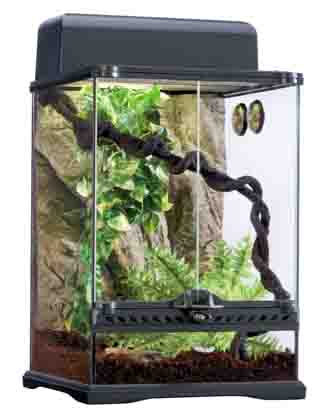
This Tropical Gecko Terrarium Kit Has Everything Needed to Get Started with a Pet Lizard
Source: Exo Terra Rainforest Habitat from Amazon
Single lizards can be kept in a 10 gallon cage. Add 10 gallons for each additional pet. Each cage requires a substrate that lines the bottom of the tank. Good choices are Eco Earth, or paper pulp purchased from a pet store. Calcium sand may be consmed by the lizard and cause health problems, although this is rare. Each lizard has a required temperature range for daytime and then 5 to 10 degrees cooler at night. The best approach is to create a temperature gradient, with one end of the cage heated with a heat pad. The temperature range for most cages is 90F on the heated end of the tank, with the cooler end at 75F (24 C and 32C). Avoid heaters that are in articficial rocks since these can harm the lizard.
You can either buy a kit that includes everything needed to get started, or you can create your own.
For detailed instructions read our guide to setting up a lizard terrarium.
Gecko Diet
A Gecko is a insectovore, which means the primary source of protein is insects. All components of the diet can be purchased live in a pet store or even online from Amazon.com. Fresh mealworms, waxmoth larvae, locusts or crickets (black or brown) can be bred by an owner for the sole purpose of providing food. Adults eat 2 to 5 crickets each day. Feed the crickets (gut loaded) before feeding to your lizard. It is best to feed the lizard a variety of insects.Supplements are also required, since lizards in captivity do not have the same access to food. Both a calcium supplement and vitamin powder will provide the required nutrition. Insects are dusted with the powders prior to placement in the terrarium or the powder can be provided in a dish separate from a shallow water dish. Misting the aquarium will encourage the lizard to drink in water droplets. DO NOT mist with cold water in order to avoid shocking the lizard.
Feed these lizards at night since they are nocturnal. Young lizards need to be fed 2 small meals, one in the morning and one at night.
Descriptions of Popular Pet Geckos
Leopard Geckos (Eublepharis macularius)
The leopard lizard is one of the most popular
pet reptiles and is different than others in this species since they do
not make noice, they have eyelids and they are missing the sunction
pads that enable others to climb the walls of any terrarium.. Their
small size makes it easy to care for two to three in a 10
gallon or 15 gallon reptile cage (only 1 male) that is 18" to 20"
long. They are a highly recommended place
to start for a beginner. The lizards come in many colors and grow
to 7 to 12 inches. They can live as long as 10 to 22 years, so be
prepared for a long term commitment. The diet consists of crickets,
mealworms and waxworms. Commercial food is also available.What makes the Leopard unique from others is that they do not have the lamellae that act as an adhesive to the sides of a glass aquarium. They also have outside eyelids and ears. The leopard does not need an ultraviolet light.
The Leopard is a desert species, so conditions should mimic the desert. The terrarium should be lined with paper towels or reptile carpet when the lizard is a baby or juvenile. Once the lizard becomes an adult, then the substrate can be changed to reptile or calcium sand. There is a small risk of digestive impaction with sand, so if you prefer a reptile carpet or paper towel also makes for a good gecko substrate. Do not place the terrarium in direct sunlight and away from cold drafty areas. Follow guidelines for terrariums above. Provide a separate hiding space for each lizard.
- Leopard Terrarium Temperature:
- Daytime non-basking area: 80F - 85F
- Daytime basking area: 90F
- Nightime temperature, all areas: 70F
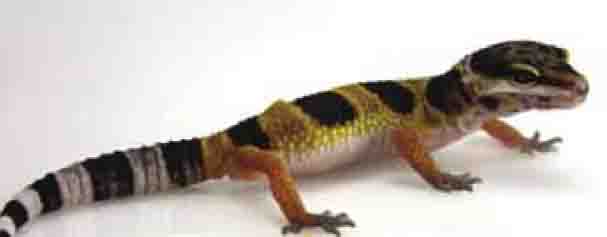
The Leopard is one of the most popular reptile pets due to its' small size that since it is naturally clean. They are the perfect choice for the beginner.
Source: Petco
For more information download this brochure on leopard care from Petco.
Fat-tailed Gecko (African Fat Tailed)
The flat tailed grows to 5 to 8 inches long and will live to 15 or more years. Like the Leopard the diet consists of various insects. Only buy captive bred lizards since those caught in the wild do not always acclimate well to captivity. Any enclosure should be at least 1 foot x 2 feet. Be careful handling, because if dropped they could be injured. The diet is the same as others of this species.For more information download this fact sheet on Fat Tailed care.
Crested Geckos (Rhacodactylus
Auriculatus)
The Crested is 5 to 8 inches long and has
an average life span of 5 to 10 years. The specie makes an excellent
and easy to care for pet. They make
great reptile pets and eat a commercial or insect based diet. They need
to eat 2 to 3 time a week. There is a high quality MRP
(meal replacement powder) that is highly regarded and
fulfill all dietary requirements. Two or three Cresteds can be
kept in a
10 gallon reptile terrarium. For more information download this fact sheet on Crested care.
Gargoyle Geckos
The Gargolye can be housed in pairs, although only pair together members of the opposite sex (males will attack other male geckos, females will attack other females).. Note that members of the opposite sex are likley to breed. The lizards are 5 inches in length plus the tail. Separate babies from adults to avoid cannible behavior. This lizard is native to Grande Terre Island, New Caledonia.The Gargoyle can be housed in a 10 gallon tank (if two, 20 gallon is preferable). Note that tthe Gargoyle prefers room temperature and unlike others of this species, does not do well when the temperature exceeds 80F or go below 65F. Consider a terrarium with enough height for climbing. They also like to have hiding places in the terrarium. The Gargoyle is from more temperate areas, so live plants in the gecko terrarium will help to provide climbing and hiding areas as well as boost humidity levels. Fake plants are also acceptable, but there is a preference for live.
The Gargoyle is an omnivore and benefits from a balanced diet. A commercial option is MRP powder with or without an insect such as crickets. The powder is a popular option, even among professional herptologists since it contains all of the vitamins and food components required to maintain good health.
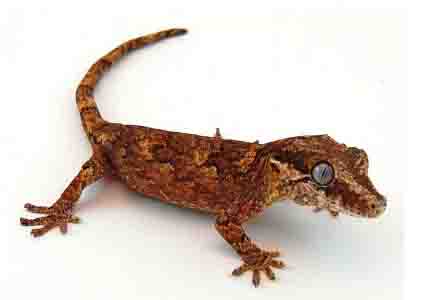
The Gargoyle Gecko is available in two colors and has the distinct bony patter on the top of the head
Source: Western New York Herptological Society
For more information, download this sheet on Gargoyle care (PDF Download).
Panther Geckos (also called
Madagascar, Ground, Ocelot, Pictus, Paroedura picta)
Panther are from a temperate environment and grow to 6 inches in
length. They differ from other geckos in their relatively small size
and in that most of their time is spent on the ground. They are native
to forested areas in Madagasgar. Like other lizards, they will do
well in a 10 gallon terrarium.Since they come from the forrest, they require a humidity level of 30% to 50%. Daytime temperatures are 75F to 85F, with the basking area heated to 85F to 90F. Night time temperatures should be 65F to 75F. A ceramic heat lamp or other source such as a heat mat at one end of the gecko terrarium is required for the basking area. Lizard Cage substrate options are a mix of calcium sand and peat moss, coconut fiber, reptile carpet or paper toweling is recommended.
Panthers love to eat and can be fed a different insect each day. Preferred insects are crickets and black soldier fly larvae. A calcium supplement suppled per the manufacturers instructions (usually several times a day) is also recommended.
Tip: Misting the aquarium every day will improve humidity levels and encourage the lizard to drink water.
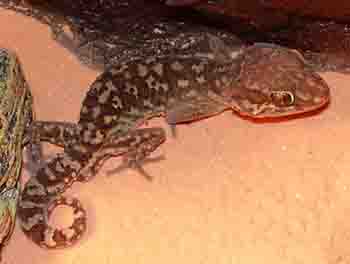
The Panther Gecko is known for its preference for staying on the ground. Only babies or juveniles are known to climb the sides of the aquarium
Source: Wikimedia, Harlem
For more information download this care sheet on the Panther (PDF).
Crocodile Geckos (Tarentola Mauritanica)
The Crocodile Gecko is named for its' crocodile like appearance, which includes a head that is covered with rows of bumps. This lizard will grow to 6 inches long and will live 8 or more years in captivity. They thrive in an aquarium that is a 10 gallon or 20 gallon gecko terrarium. These lizards can climb the aquarium walls and walk upside down.Required daytime temperature is 70F with a heat mat under 1/2 of the tank at 85F. Nightime temperatures need to be 60F to 70F. The Crocodile diet consists of insects such as mealworms, crickets and waxworms. Babies and juveniles should be fed gut loaded small crickets (crickets that are fed prior to feeding to the lizard). Humidity levels need to be at 60%.
Download this guide to Crocodile care (PDF).
White Lined Geckos
The white lined gecko is named for the white line that runs down the lizards back. It is one of the larger geckos, growing to 8: to 10" in length. The lizard comes from forrested areas and can climb the walls of any terrarium. The white-lined gecko diet consits of insects such as crickets plus a vitamin and mineral supplement. They thrive in a 10 gallon or 20 gallon tank.Required daytime temperatures are 80F to 86F. The heated basking area should be at 85F to 90F. Night time temperatures are 70F to 75F. High humidity levels of 70% to 80% are also required. One way to keep humidity levels high is to mist the aquarium every day. Live plants will also help to maintain humidity. A shallow water dish and water droplets on plants that can be licked will make sure that the lizard drinks enough water.
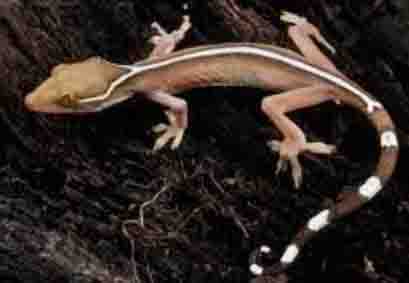
The White Lined Gecko is named for the pronounced line down the back
Source: Tarbiyah Home School
Golden Geckos (Gekko ulikovskii)
The Golden Gecko is from rain forests in Vietnam. Females grow to 5" to
6", while males can grow as large as 7". The Golden becomes stressed
when handled. The lizard should be kept in a 10 gallon gecko terrarium
with decor typical to a tropical setting including climbing limbs. The
Golden eats a diet of crickets, waxworms, super worms and
mealworms. Uneaten live crickets should not remain in the cage
since they are known to bite Goldens.Daytime temperatures are 78F to 85F. A heat mat is only needed to maintain the suggested temperature gradient. UVB lights are also not needed. Select a lizard cage substrate that helps to retain moisture and humidity such as Eco Earth.
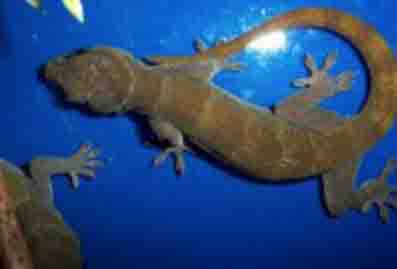
The Golden Gecko does not like to be handled
Source: Western Heptological Society
Have a Lizard Related Question for our Vet? We Will Answer it for Free!
Do you need some pet lizard advice? Just ask a question and our Vet will answer it as soon as possible.
If your question is medical or behavior-related, please include information such as species, age, diet, habitat, and anything related to the medical history of your lizard.
Please upload a picture of your lizard, especially if you believe it will help the Veterinarian. Please know that we receive many questions and answer them on a first-come, first-served basis. If you need an immediate response, we suggest you use this online veterinary service that is available now to answer your questions.
References:
The 25 Best Reptile and Amphibian PetsR.D. Bartlett
GGA
Michael Andreas Jacobi, ExoticFauna.
Willmet Pet Center, Wilmette, IL
Best West Pet Foods
Western New York Herpetological Society
From Geckos as Pets to Cool Small Pets home page
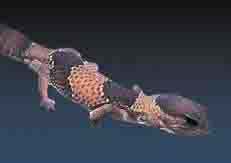
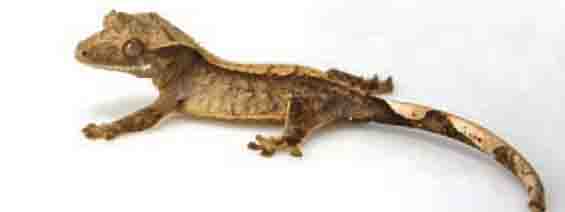
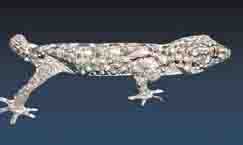
Comments
Have your say about what you just read! Leave me a comment in the box below.